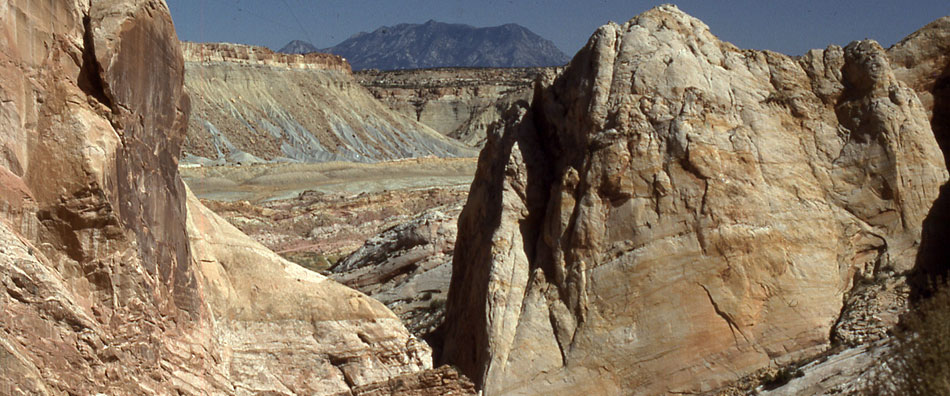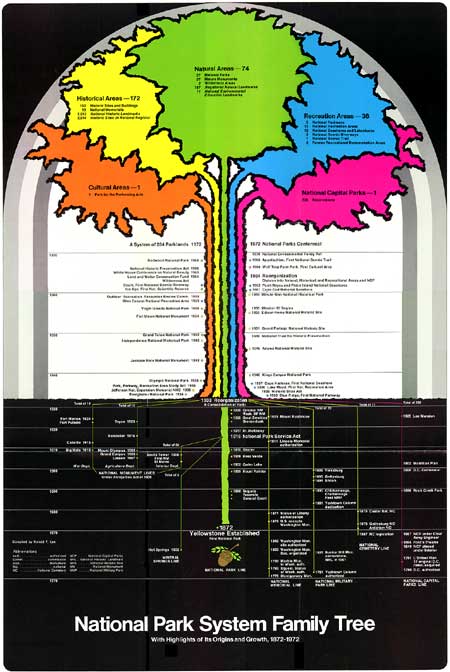
CELEBRATING THE NATIONAL PARK SERVICE CENTENNIAL • 1916-2016

Capitol Reef National Park
|
The following National Park System timeline has been extracted from Family Tree of the National Park System written by Ronald F. Lee to commemorate the centennial of the world's first national park — Yellowstone — in 1972. ESTABLISHMENT AND GROWTH OF THE NATIONAL PARK SYSTEM, 1916-1933 
A new era for National Parks and Monuments opened on August 25, 1916, forty-four years after the establishment of Yellowstone, when President Woodrow Wilson signed legislation creating a new Federal bureau, a National Park Service. This action culminated years of effort by distinguished citizens and legislators including among others, J. Horace McFarland, President of the American Civic Association; Secretaries of the Interior Walter Fisher and Franklin K. Lane; Presidents William Howard Taft and Woodrow Wilson; Frederick Law Olmsted, Jr.; Representatives William Kent and John E. Raker of California; Senator Reed Smoot of Utah; and, of course, Stephen T. Mather and Horace M. Albright. The need for a separate bureau to administer and coordinate policies and plans for the National Parks and National Monuments had become widely recognized by 1916. The act created a bureau to "promote and regulate the use of the Federal areas known as national parks, monuments, and reservations hereinafter specified by such means and measures as conform to the fundamental purpose of the said parks, monuments, and reservations, which purpose is to conserve the scenery and the natural and historic objects and the wild life therein and to provide for the enjoyment of the same in such manner and by such means as will leave them unimpaired for the enjoyment of future generations." The act provided that the Service would supervise the National Parks and National Monuments then under the jurisdiction of the Department of the Interior, together with the Hot Springs Reservation in Arkansas, and such other National Parks and reservations of like character as Congress might thereafter establish. On August 25, 1916, the Interior Department administered 14 National Parks, 21 National Monuments (including Pinnacles, California, transferred from the Department of Agriculture to Interior in 1910), the Hot Springs Reservation and Casa Grande Ruin. Thus the new Service was launched with responsibilities for 37 diverse areas. When the Service was established, a new idea—the National Park System—was also born. Before 1916 there were individual National Parks and National Monuments but they were uncoordinated and there was no System. Between 1916 and 1933,1 Stephen T. Mather and Horace M. Albright, the first and second Directors of the Service, with the support of successive Secretaries of the Interior, Presidents, Members of Congress, conservationists, writers, and others laid the foundations for today's National Park System. Here lie the roots of National Park Service policies and programs still familiar to visitors and employees today — the uniformed ranger service, the information and interpretive programs, and the professional wildlife, forestry, historical, architectural, and landscape services. 1 The precise period meant here is from August 25, 1916, when enabling legislation was enacted to establish the National Park Service, to June 10, 1933, when President Franklin D. Roosevelt signed Executive Order 6166 substantially enlarging the National Park System. During this period, in spite of the dislocations of World War I and the onset of the Great Depression, the National Park System was almost doubled in size. Public lands could still be secured for National Parks and Monuments, and large wilderness tracts were set aside while there was still time. This was the period when Americans began to take to the automobile to "See America First." Four cars were registered in 1895, eight thousand in 1900, nearly half a million in 1910, and twenty-three million in 1930. The National Park System (1) grew substantially larger; (2) was extended into the eastern United States, becoming truly national; and (3) historical holdings were quadrupled and the groundwork laid for a coordinated national historic preservation program. Here is the record up to but not including the Reorganization of 1933:
The increase in natural area holdings is spectacular. Six new National Parks were authorized or established, six more were created out of National Monuments or other reservations, eleven new scientific National Monuments were proclaimed from Interior Department lands, and one was authorized by Congress. Each had its own unique qualities and history. These twenty-four reservations, including all subsequent additions, embraced more than 11-1/2 million acres in 1970, more than two-fifths of the acreage in the whole System. The first of these great reservations was Mount McKinley National Park, Alaska, authorized in 1917 to protect the Dall or white Alaska mountain sheep, caribou, Alaska moose, grizzly bear and other wildlife from threatened depletion or extinction. It is the second largest National Park, focusing on Mount McKinley, the highest mountain in North America, rising 20,320 feet from low surrounding terrain, "magnificently aloof among its mountain neighbors." Two great Alaskan National Monuments—Katmai, proclaimed in 1918, and Glacier Bay, in 1925 — are each larger than any National Park, making them the largest areas in the System. Katmai contains 2,792,137 acres and was created to protect the scene of one of the greatest volcanic eruptions of recorded history, which occurred in June 1912, leaving behind the famous Valley of Ten Thousand Smokes. Glacier Bay, containing 2,803,586 acres, protects some twenty great tidewater glaciers and their mountain setting, together with abundant Alaskan wildlife. For the first time, four of the new National Parks were situated in the eastern United States, a highly significant development. Three were authorized in 1926. The Great Smoky Mountains National Park, North Carolina Tennessee, protects the highest section of the Appalachian Mountains, where sixteen peaks top 6,000 feet. Shenandoah National Park conserves more than 100 miles of the irregular crest of the Blue Ridge in Virginia, affording superb views of the Shenandoah Valley and surrounding country. Mammoth Cave National Park was established to protect a great limestone cavern in southwestern Kentucky from commercial exploitation and make its five levels and extended portions of its 150 miles of underground passages accessible to the public. Isle Royale National Park, Michigan, was authorized in 1931 to protect a forty-five-mile-long wilderness island in Lake Superior, notable for its moose and timber wolves and prehistoric copper mines, and surrounded by 200 smaller islands and countless minor rocks. Lastly, the Sieur de Monts National Monument in Maine was made a National Park in 1919 and renamed Acadia in 1929. Thus five National Parks situated in six widely dispersed eastern states were added to the System during this period—not carved out of the public domain as western parks had been, but acquired the hard way by purchase or donation. All the other natural areas added to the System during this period were situated in the west. They included six more famous National Parks—Grand Canyon, Zion, Bryce, Hot Springs, Grand Teton, and Carlsbad Caverns; and ten more scientific National Monuments, among them, Death Valley, the fifth largest area in the System, and Lava Beds, Arches, Craters of the Moon, Great Sand Dunes, White Sands and Badlands. Taken altogether the 24 natural areas added to the System in only 17 years between 1916 and 1933 represent a remarkable achievement, a star-spangled list. The increase in historical holdings during this period was also significant, pointing the way toward the remarkable Reorganization of 1933. Seven prehistoric areas were added to the System, including spectacular Canyon de Chelly, Arizona, where Navajo Indians still live, the largest archaeological reservation in the System, larger even than Mesa Verde; and Bandelier National Monument, New Mexico, the third largest archaeological area. Among six new historical areas were the first to be added to the System in the east — significant forerunners of many more to follow. George Washington Birthplace National Monument, on the banks of the Potomac River at Wakefield, Virginia; Colonial National Monument, embracing Jamestown and Yorktown, and closely related both geographically and historically to Colonial Williamsburg, Virginia; and Morristown National Historical Park, New Jersey, Washington's headquarters during two severe winters of the Revolutionary War — these three areas launched the Service on a new course in historic preservation destined to influence greatly the future growth of the System. | |||||||||||||||||||||||||||||||||||||||||||||||||||||||||||||||||||||||||||||||||||||||||||||||||||||||||||||||||||||||||||||||||||||||||||||||||||||||||||||||||||||||||||||||||||||||||||||||||||||